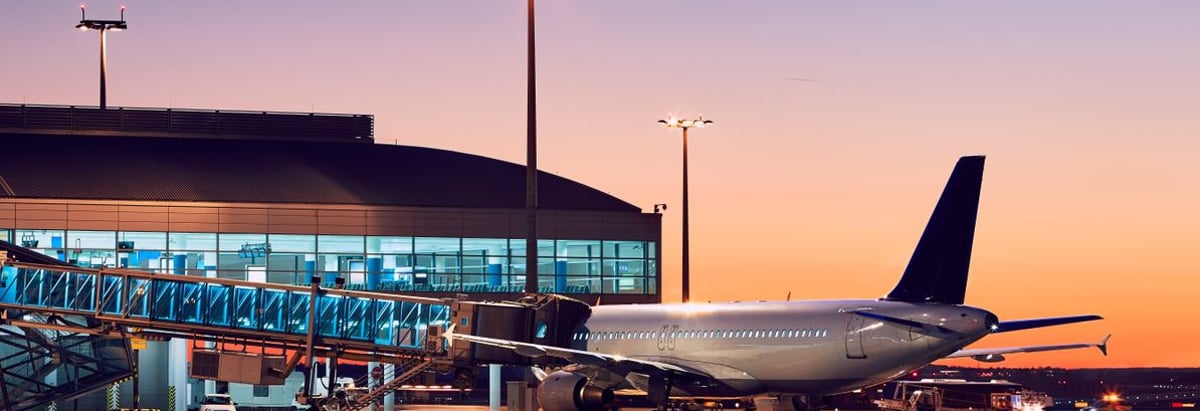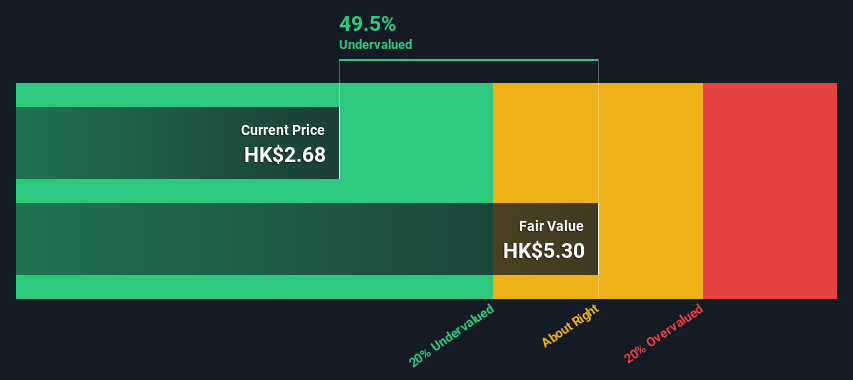- Hong Kong
- /
- Infrastructure
- /
- SEHK:694
Are Investors Undervaluing Beijing Capital International Airport Company Limited (HKG:694) By 49%?

Key Insights
- Beijing Capital International Airport's estimated fair value is HK$5.30 based on 2 Stage Free Cash Flow to Equity
- Beijing Capital International Airport is estimated to be 49% undervalued based on current share price of HK$2.68
- Our fair value estimate is 85% higher than Beijing Capital International Airport's analyst price target of CN¥2.87
In this article we are going to estimate the intrinsic value of Beijing Capital International Airport Company Limited (HKG:694) by taking the expected future cash flows and discounting them to today's value. We will use the Discounted Cash Flow (DCF) model on this occasion. Models like these may appear beyond the comprehension of a lay person, but they're fairly easy to follow.
Companies can be valued in a lot of ways, so we would point out that a DCF is not perfect for every situation. If you want to learn more about discounted cash flow, the rationale behind this calculation can be read in detail in the Simply Wall St analysis model.
See our latest analysis for Beijing Capital International Airport
The Calculation
We're using the 2-stage growth model, which simply means we take in account two stages of company's growth. In the initial period the company may have a higher growth rate and the second stage is usually assumed to have a stable growth rate. In the first stage we need to estimate the cash flows to the business over the next ten years. Where possible we use analyst estimates, but when these aren't available we extrapolate the previous free cash flow (FCF) from the last estimate or reported value. We assume companies with shrinking free cash flow will slow their rate of shrinkage, and that companies with growing free cash flow will see their growth rate slow, over this period. We do this to reflect that growth tends to slow more in the early years than it does in later years.
A DCF is all about the idea that a dollar in the future is less valuable than a dollar today, and so the sum of these future cash flows is then discounted to today's value:
10-year free cash flow (FCF) estimate
| 2025 | 2026 | 2027 | 2028 | 2029 | 2030 | 2031 | 2032 | 2033 | 2034 | |
| Levered FCF (CN¥, Millions) | CN¥1.38b | CN¥1.70b | CN¥1.93b | CN¥2.14b | CN¥2.31b | CN¥2.46b | CN¥2.58b | CN¥2.69b | CN¥2.79b | CN¥2.89b |
| Growth Rate Estimate Source | Analyst x1 | Analyst x1 | Est @ 14.04% | Est @ 10.53% | Est @ 8.07% | Est @ 6.35% | Est @ 5.15% | Est @ 4.31% | Est @ 3.72% | Est @ 3.30% |
| Present Value (CN¥, Millions) Discounted @ 12% | CN¥1.2k | CN¥1.4k | CN¥1.4k | CN¥1.4k | CN¥1.3k | CN¥1.3k | CN¥1.2k | CN¥1.1k | CN¥1.0k | CN¥952 |
("Est" = FCF growth rate estimated by Simply Wall St)
Present Value of 10-year Cash Flow (PVCF) = CN¥12b
We now need to calculate the Terminal Value, which accounts for all the future cash flows after this ten year period. The Gordon Growth formula is used to calculate Terminal Value at a future annual growth rate equal to the 5-year average of the 10-year government bond yield of 2.3%. We discount the terminal cash flows to today's value at a cost of equity of 12%.
Terminal Value (TV)= FCF2034 × (1 + g) ÷ (r – g) = CN¥2.9b× (1 + 2.3%) ÷ (12%– 2.3%) = CN¥31b
Present Value of Terminal Value (PVTV)= TV / (1 + r)10= CN¥31b÷ ( 1 + 12%)10= CN¥10b
The total value, or equity value, is then the sum of the present value of the future cash flows, which in this case is CN¥23b. To get the intrinsic value per share, we divide this by the total number of shares outstanding. Relative to the current share price of HK$2.7, the company appears quite undervalued at a 49% discount to where the stock price trades currently. Remember though, that this is just an approximate valuation, and like any complex formula - garbage in, garbage out.

Important Assumptions
The calculation above is very dependent on two assumptions. The first is the discount rate and the other is the cash flows. If you don't agree with these result, have a go at the calculation yourself and play with the assumptions. The DCF also does not consider the possible cyclicality of an industry, or a company's future capital requirements, so it does not give a full picture of a company's potential performance. Given that we are looking at Beijing Capital International Airport as potential shareholders, the cost of equity is used as the discount rate, rather than the cost of capital (or weighted average cost of capital, WACC) which accounts for debt. In this calculation we've used 12%, which is based on a levered beta of 1.886. Beta is a measure of a stock's volatility, compared to the market as a whole. We get our beta from the industry average beta of globally comparable companies, with an imposed limit between 0.8 and 2.0, which is a reasonable range for a stable business.
Next Steps:
Whilst important, the DCF calculation shouldn't be the only metric you look at when researching a company. DCF models are not the be-all and end-all of investment valuation. Instead the best use for a DCF model is to test certain assumptions and theories to see if they would lead to the company being undervalued or overvalued. For instance, if the terminal value growth rate is adjusted slightly, it can dramatically alter the overall result. What is the reason for the share price sitting below the intrinsic value? For Beijing Capital International Airport, there are three relevant factors you should assess:
- Risks: For instance, we've identified 1 warning sign for Beijing Capital International Airport that you should be aware of.
- Future Earnings: How does 694's growth rate compare to its peers and the wider market? Dig deeper into the analyst consensus number for the upcoming years by interacting with our free analyst growth expectation chart.
- Other High Quality Alternatives: Do you like a good all-rounder? Explore our interactive list of high quality stocks to get an idea of what else is out there you may be missing!
PS. Simply Wall St updates its DCF calculation for every Hong Kong stock every day, so if you want to find the intrinsic value of any other stock just search here.
If you're looking to trade Beijing Capital International Airport, open an account with the lowest-cost platform trusted by professionals, Interactive Brokers.
With clients in over 200 countries and territories, and access to 160 markets, IBKR lets you trade stocks, options, futures, forex, bonds and funds from a single integrated account.
Enjoy no hidden fees, no account minimums, and FX conversion rates as low as 0.03%, far better than what most brokers offer.
Sponsored ContentValuation is complex, but we're here to simplify it.
Discover if Beijing Capital International Airport might be undervalued or overvalued with our detailed analysis, featuring fair value estimates, potential risks, dividends, insider trades, and its financial condition.
Access Free AnalysisHave feedback on this article? Concerned about the content? Get in touch with us directly. Alternatively, email editorial-team (at) simplywallst.com.
This article by Simply Wall St is general in nature. We provide commentary based on historical data and analyst forecasts only using an unbiased methodology and our articles are not intended to be financial advice. It does not constitute a recommendation to buy or sell any stock, and does not take account of your objectives, or your financial situation. We aim to bring you long-term focused analysis driven by fundamental data. Note that our analysis may not factor in the latest price-sensitive company announcements or qualitative material. Simply Wall St has no position in any stocks mentioned.
About SEHK:694
Beijing Capital International Airport
Engages in the aeronautical and non-aeronautical businesses at the Beijing Capital Airport in the People’s Republic of China.
Reasonable growth potential and slightly overvalued.
Similar Companies
Market Insights
Community Narratives


